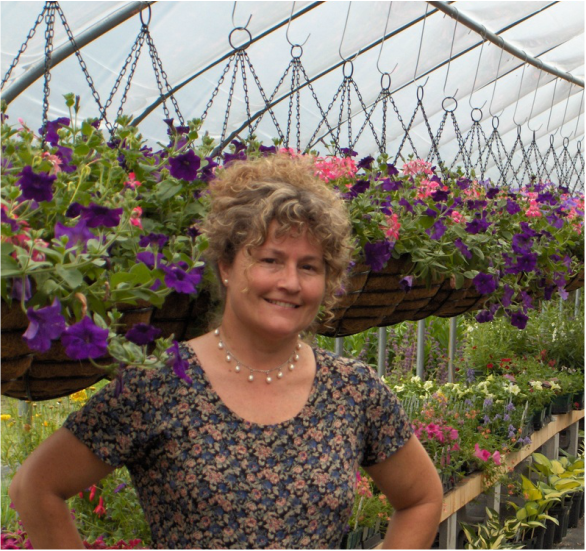
A landscape designer gets her hands dirty.
This piece first appeared in The Vermont Standard.
Liz Krieg says she’s the happiest girl in central Vermont. The new Garden Design and Greenhouse Manager at Chippers in Woodstock is “wicked excited” about her job. “Everything I’ve ever needed or wanted is here at my fingertips,” she says, “these guys have got backhoes, dump trucks, and every tool I’ve ever lusted for.”
For 15 years until this past February, Krieg had been the sole proprietor of Rising Sun Greenhouses and Landscape Company. And while she’s always had a plentiful supply of expertise and energy, her move to Chippers multiplied the means she has for applying them. So now she’s bubbling over with plans to bring her ideas to a wider audience. Krieg will oversee cultivation of garden plants in a brand new 100 by 30 foot greenhouse, and in an outdoor nursery. The new division will sell the plant material wholesale to nurseries, landscapers, municipalities, institutions and garden clubs. It will also offer planning, installation and maintenance services for landscapes, gardens and outdoor living spaces. And Krieg will continue to design and install decorative plantings in containers for seasonal customers as well as for weddings and other one-time events and celebrations.
Her aesthetic, Krieg says, is flexible according to the needs of her client. They’ll put their heads together, Krieg will study the property, and then flesh out a concept at her drafting board. She’s designed gardens for a range of motifs including modern, arts and crafts, English cottage, and Italianate; she’s incorporated restful, low-maintenance perennials as well as “bodacious” container plantings.
In her own home garden, Krieg loves incorporating American natives, plants that have grown naturally on the continent for a long time. “The English are the grandfathers of gardening, but once America was discovered, everybody was coming here to collect plants,” she says, “we have really supplied the world with some of the most fantastic species of plant materials.” She points to the vibrant yellow of the black-eyed susan (rudbeckia), the purple coneflowers of the echinacea, and the rich crimson of the lobelia cardenalis as stunning examples. Penstemons, commonly known as beard-tongue, are her favorite, “they’re beautiful little spikes of blue or pink or white flowers, they’re lovely.” A few years ago, when Krieg couldn’t find varieties of huechera, a native with low, showy foliage and spears of delicate blooms, she began growing many herself, in a rainbow of leaf colors.
It’s not just looks that draws Krieg to indigenous flowering plants. She loves the hummingbirds, nectarivorous butterflies, and most particularly the delicate, hummingbird-like sphinx moths that frequent her garden. “They love natives more than any other flower,” she says, “they are genetically predisposed to look for sap from native plant material.”
Krieg also delights in the unusual; she’ll use herbs, for example, in ornamental plantings. Parsley is a great filler, she says, it has fantastic texture and looks beautiful with flowering annuals. Then there’s a relatively new basil, pesto perpetuo, with a silvery-rimmed, deep green leaf; it’s one of many ornamental basils that Krieg loves to grow. And she often uses decorative herbs and flowering or ornamental vegetable plants, like the gorgeous-leaved eggplant, in potagers, charming little kitchen gardens. The concept dates back to the 16th century; a potager is arranged in a formal pattern, with blocks of visually pleasing, and useful, plantings bordered by well-defined paths. It’s the kind of garden that works well in a tight courtyard-type space, or even in a container.
Although she loves gardening now, Krieg did not feel affection early-on for her future occupation. “When I was a young girl, my mother made me take care of her houseplants, and I hated it,” she recalls. But as a “hippie” in the 1970’s, she read Helen and Scott Nearing’s homesteading book, Living the Good Life, and, “bought it lock, stock, and barrel.” She tilled an acre of land, planted it all with vegetables, then “canned and froze everyone of them.” Krieg planted a few flowers, but she couldn’t bring herself to discard any of the seedlings, she just kept lining them out in rows. People began to stop and ask to buy cut flowers. “I found that ornamental horticulture really sang to me,” she says.
After moving to Vermont in the late 1980’s, Krieg formalized her accumulating hands-on education with an Associates Degree in Landscape Design and Sustainable Horticulture from Vermont Technical College, then followed that with a Bachelor of Science from Johnson State College. She’s since added certifications as a Vermont Horticulturist and Master Gardener, and accreditation as an Organic Land Care Professional.
Chippers, a 70-some-employee, multi-location provider of tree preservation, turf and soil care, land enhancement, and forestry services was founded in 1986 by the late William Russell. Krieg began working with Russell and his wife and partner Mundy Wilson five years ago, on a few joint projects. The couple had been talking about the idea of folding Krieg’s business into Chippers before Russell passed away last summer.
Now that the idea has reached fruition, both Wilson and Krieg are excited about the potential of their merger. In addition to the new menu of garden-related services at Chippers, Wilson and Krieg plan to collaborate on a series of winter classes that will “span everything from seed to tree,” says Krieg. The curriculum may include sessions on topics like small fruits for the home grower, soil science, and rock gardening.
Every day of making plans and getting the new division going has been a “happy, happy day” for Krieg. “If that’s my job on earth, to inspire people to garden and to love gardening, I’ll take it,” she says, “I want everybody to have flowers and lots of them.”
